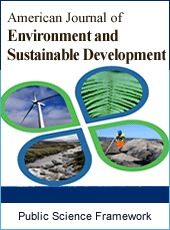American Journal of Environment and Sustainable Development
Articles Information
American Journal of Environment and Sustainable Development, Vol.4, No.2, Jun. 2019, Pub. Date: Apr. 29, 2019
Heavy Metal Levels in Plants Growing on Abandoned Coal Ash Dumpsite in Oji, Enugu State, Nigeria
Pages: 43-49 Views: 2183 Downloads: 533
[01]
Enenchi Marcel Igwenagu, Department of Polymer and Textile Engineering, Nnamdi Azikiwe University, Awka, Nigeria.
[02]
Okoye Patrice Anthony Chudi, Department of Pure and Industrial Chemistry, Nnamdi Azikiwe University, Awka, Nigeria.
[03]
Ogbuagu Josephat Okey, Department of Pure and Industrial Chemistry, Nnamdi Azikiwe University, Awka, Nigeria.
[04]
Ubaoji Kingsley Ikechukwu, Department of Applied Biochemistry, Nnamdi Azikiwe University, Awka, Nigeria.
The levels of thirteen metals; Fe, Mn, Ni, Cd, Pb, Cr, Co, As, Zn, Cu, Mo, Se and Hg in the leaves of five common plant species (Abelmoschus esculenta, Aspilia africana, Manihot esculenta, Panicum maximum and Zea mays), growing around the coal ash dump site at Oji, Enugu State were evaluated. The leaves were collected from the plants at the four cardinal points of the study area and analyzed for heavy metals using Atomic Absorption Spectrometer (AAS) Varian 240AA. The results showed that the concentration of the metals; Ni, Pb, Cd, Co, As, Mo and Se were above the USEPA set limits for the selected plant leaves, and varied with the following sequence; Ni (1.10±0.57to 7.05±12.86 mg/kg), Pb (6.45±5.75 to 9.25±5.43 mg/kg), Cd (1.13±0.34 to 5.23±6.55mg/kg), Co (0.05±0.10 to 1.55±1.84mg/kg), Cr (0.025±0.04 to 0.05±0.09mg/kg), As (4.13±6.54 to 22.53±30.69mg/kg), Mo (7.03±12.96 to 25.45±20.96 mg/kg), and Se (7.93±9.63 to 15.45±10.70 mg/kg). Also, the result showed that the metals concentration were higher in the study area than the control except iron (Fe). Considering the importance of plants in the food chain, we recommend for soil remediation if the study area must be used for farming or as grazing ground.
Heavy Metals, Plant Leaves, Soil Remediation, Atomic Absorption Spectrometer
[01]
Brun, L. A., Maillet, J., Hinsinger, P., and Pepin, M., (2001). Evaluation of copper availability toplants in copper-contaminated vineyard soils. Environmental Pollution 111: 293–302.
[02]
Dan, T., Hale, B., Johnson, D., Conard, B., Sitiebel, B. and Veska, E. (2008). Toxicity thresholds foroat (Avena sativa L.) grown in nickel (Ni) agricultural soils near Port Colbome, Ontario Canada. Journal of Soil Science, 88: 389-398.
[03]
Essiett, U. A., Effiog, G. S., Ogbemudia, F. O., and Bruno, E. J. (2010). Heavy metal concentrations inplants growing on crude oil contaminated soil in Akwa Ibom State, South Eastern Nigeria. AfricanJournal of Pharmacy and Pharmacology, 4(7): 465-470.
[04]
Ghosh, K. G., Kaustuv, M., and *Sunil, S. (2015). Fly ash of thermal power plants: Review of theproblems and management options with special reference to the Bakreshaw thermal power planteastern India. International Journal of Geology, Earth & Environmental Sciences ISSN: 2277-2081(Online) Available at http://www.cibtech.org/jgee.htm Vol. 5(2) retrieved in May 2017.
[05]
Guala, S. D., Vega, F. A., Covalo, E. F. (2010). The dynamics of heavy metals inplant-soilinteractions. Ecological modeling (Elsevier) 221: 1148-1152.
[06]
Kabata, A. and Pendias, H. (2001). Trace elements in soils and plants, CRC Press, Boca Raton, Florida, USA, 3rd edition.
[07]
Kabata, P. and Pendias, H. (2010). Trace elements in soil and plants 4th edition CRC Press, Boca Raton, Florida, pp 24-29.
[08]
Kiekens, L. (1990). Zinc, in heavy metals in soils. B. J. Alloway (ed). Blackie and son ltdBishopbriggs Glasgow pp 261-279.
[09]
McBride, J. P., Moor, R. E., Witherspoon, J. P. and Blanco, R. E.(1978). Radiological Impact ofAirborne Effluents of coal and nuclear plants. Science, 202(4372): 1045-1050.
[10]
Mishra, S., Prasad, S. V. K., and Kanungo, V. K. (2017). Impact of coal fly ash as soil amendment onphysico-chemical properties of soil. Indian Journal of Science Research 13(2): 15-20.
[11]
Nedelkoska, T. V. and Doran, P. M. (2000). Characteristic of heavy metal uptake by plant specieswith potential for phytoremediation and phytomining. Miner England, 13: 549-561.
[12]
Obasi, N. A., Elom S. O., Edeogu C. O., Alisa, C. O. and Obasi, S. E. (2014). Soil Environmentalmetals speciation and associated health risks in selected edible leafy plants on Amaéchi and Four-Corner Dumpsites in Enugu of Enugu State, Nigeria. International Journal of Life Science Biotechnology & Pharmacological Resource 3 (4): 152-165.
[13]
Okeke, C. U., Ekanem, E. O. and Harami, A. M. (2014). Bioaccumulation of heavy metals in mechanicworkshops. International Journal of Mathematics and Physical Sciences Research, 2(1): 58-65.
[14]
Opaluwa, O. D., Aremu, M. O., Ogbo, C. O., Abiola, K. A., Odiba, I. E., Abubaka, M. M. and Nweze, N. O. (2012). Heavy metal concentrations in soils, plant leaves and crops grown around dump sites inLafia metropolis, Nasarawa State, Nigeria. Advances in Applied Science Research, 3(2): 780-784.
[15]
Rafi, U., Jehan, B., Mohammad, S., Madiha, I., Ayub, K. and Muhammad, S. (2011). Phyto-accumulation of heavy metals by sunflower (Helianthus annuus L.) grown on contaminated soil. African Journal of Biotechnology 10(75): 17192-17198.
[16]
Shirkhanloo, H., Seyed, A., Hajiseyed, M., Nasrin, S., Ali, M. S. and Farahani, H. (2015): Theevaluation and determination of heavy metals pollution in edible vegetables, water and soil in thesouth of Tehran province by GIS. Archives of Environmental Protection, 41(2): 64-74.
[17]
Steinnes, E. in Alloway, B. J. (1995). Mercury (Ed.), Heavy metals in soils. (2nd ed.). New York: Wiley pp. 245–259.

ISSN Print: Pending
ISSN Online: Pending
Current Issue:
Vol. 6, Issue 4, December Submit a Manuscript Join Editorial Board Join Reviewer Team
ISSN Online: Pending
Current Issue:
Vol. 6, Issue 4, December Submit a Manuscript Join Editorial Board Join Reviewer Team
| About This Journal |
| All Issues |
| Open Access |
| Indexing |
| Payment Information |
| Author Guidelines |
| Review Process |
| Publication Ethics |
| Editorial Board |
| Peer Reviewers |


